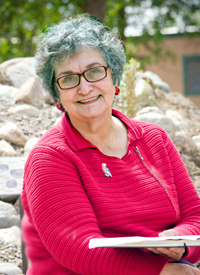JoAnn Anglin

JoAnn Anglin was part of the Local Poet Program at the Cache Creek Nature Preserve.How long have you been coming to the preserve?
I started about 5 years ago when they began the Local Poet Program. It’s a little bit of a drive, because I’m coming from Sacramento, but it is definitely well worth it both in terms of a retreat from the city and also in terms of inspiration for my writing work.
Can you tell us the basics of the program?
When this quarry was reclaimed and turned into a nature center, one of the elements that was put in and supported by the former owners, the Teichert Company, is the Local Poet Program. Now typically we come out for a period of once a week for ten weeks. It’s a combination of getting to know the natural elements of the place and using that as an inspiration for our writing. Sometimes the writing is specifically about the place, but sometimes it just triggers some kind of inspirational link. It’s a nice change from your normal life.
What inspiration have you taken from the preserve? How has that shaped your poetry and your writing?
It builds on something I did a long time ago. I worked for State Parks writing copy for exhibits. Each project, you would have to immerse yourself either into the human or the natural history of that project. So to me this kind of builds on something that was there but maybe hadn’t been used for a while. I come with an incredible respect for saving places, little breathing places for people to go to. This makes me feel, on a personal level, that I am furthering my own growth and knowledge and then, on an artistic level, that I am producing work that, maybe, some element of it will go to other people who read my poems.
How does the interaction between natural evolution and human evolution play out in your writing?
Well, in the poem I’m reading today, “The Quarry Yard,” is a good example of how understandings of the best use of the land change over time. This place was a farm, and at one time, that was seen as the best and highest use of the land. So sometimes I write about the equipment and the people in my imagination that would have lived here. Then I also became very fascinated with the variety of rocks here. I know that they have commercial uses, to put cement buildings somewhere. But I also look at each rock as having enormous history in it. Each rock goes back thousands, probably millions of years. The rocks started out at the top of a mountain, and they came here. So I like to include that sense of timelessness. The rocks are just a little piece of time that goes on.
In your art has there been any kind of exploration in that link between the rocks that have millions of years of history and the kind of industrial gravel uses that you alluded to?
I don‘t look at the industrial aspect that much. I know it’s there; it informs what I do, but I would more see it as metaphorical. It’s a way of talking about changes over time and a way of seeing how we change as individuals over time. You know, at my stage of life that is something that’s on my mind a lot: where I am now, at almost 70, to where I was when I was your age at 18-20. That personal awareness is tied in with what I write about the evolution of the land and the rocks.
Do you mind reading your poem now?
I would love to read my poem now. When I first started coming, I was struck by the infinite variety of rocks that I find here. They’re a constant reminder of what’s under our feet that we don’t see very often. At my home I have a bowl full of rocks on my coffee table, and people always start looking at them and playing with them and checking them out. Some are every shade of color from reds to greens. I especially love where these old seams show, where the rocks have melted. They’ve split, they’ve re-reconfigured, and they’ve moved together again. So the rocks were the inspiration for this poem which I call “Quarry Yard.” When I looked out one day, I was inspired to write the first line of the poem:
These rocks are like old eyes
layers of color that make up
endless depths of gray
Each striated piece – relics
compressed – accepts separations.
Has come apart along seams
releasing closeness, time filled
with seawater, now exploded
chunks. Still hard. Askew.
They have seen destiny crumble
mountains to pebbles
permanent to ephemeral
have seen questions release
answers, carving questions disguised as absolutes, despite meldings.
The past only seems inevitable from the view of now. Squints of mineral colors cling where captured
in spasms of heat and infused
upwellings, the like and the unlike somehow bonded
each asking me: what will I break into, or hold to, when
I am blasted apart?
Thank you. That was great. Do you want to add anything else?
I don’t think so. I think the work, like any art, ultimately has to stand on its own.
To download the audio, right click on the audio link above and scroll to "Save link as . . ." and choose the directory where you want to store the mp3. In Windows, you may have to use Control + S to select the link.